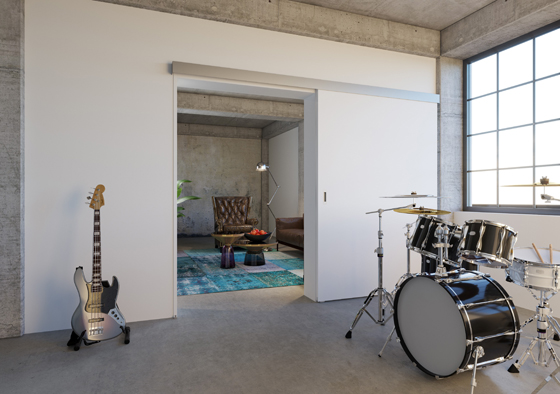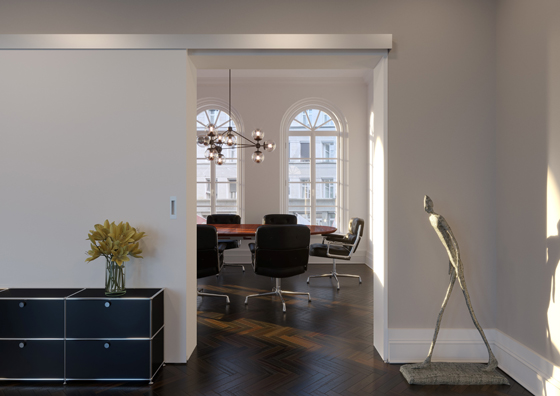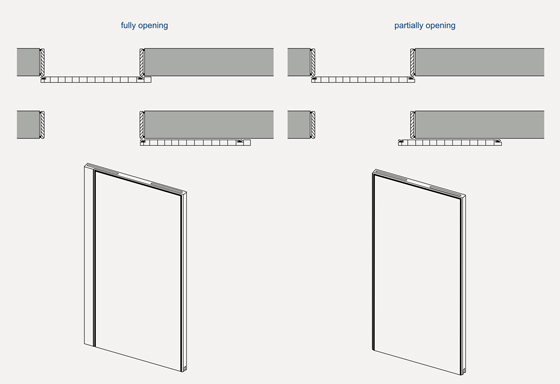On the slide: Hawa Suono
Brand story by Hawa
Suisse
24.11.17
Cette page a été archivée et n'est plus mise à jour
Sliding-door specialists Hawa Sliding Solutions have developed an innovative new sliding-door system that not only enables space-saving planning, it also cancels noise up to 39 decibels.
It's vision out and sound out with Hawa Sliding Solutions' Hawa Suono – a resolutely architectural sliding-door system, which marries space-saving planning with high-performance noise cancellation

It's vision out and sound out with Hawa Sliding Solutions' Hawa Suono – a resolutely architectural sliding-door system, which marries space-saving planning with high-performance noise cancellation
×If you have a moment you could do worse than watch international sound consultant Julian Treasure’s TED talk entitled “Why architects need to use their ears”. “We’re designing environments that make us crazy,” he argues.
In our pursuit of creating highly photogenic spaces that engage and delight us on a visual level – in other words which look great, and which serve to elevate the profile of their architects via their dissemination in the form of beautiful, carefully staged images – we’ve neglected the other senses. In particular, the aural.
It’s becoming increasingly apparent that unchecked, unmanaged sound levels are having a negative impact on us. “Sound affects us physiologically, psychologically, cognitively and behaviourally,” explains Treasure, “even if we’re not conscious of it.” Open-plan offices are, rather unsurprisingly, the number-one culprit here, but also smaller-scale environments are often sites whose acoustics are less than optimal.
The innovative new, patented Hawa Suono sliding-door system's ultra-clean lines and premium finish make it ideal for specification in both contract and domestic settings, delivering visual and aural privacy

The innovative new, patented Hawa Suono sliding-door system's ultra-clean lines and premium finish make it ideal for specification in both contract and domestic settings, delivering visual and aural privacy
×But how to square the circle? On the one hand, the home as a series of function-specific rooms, as well as smaller business premises and offices organised across separate spaces, have given way to a more open layout. This is how we’ve chosen to live and work. Yet, when it comes to sound behaviour, they’re not exactly fit for purpose.
The Swiss-based manufacturer Hawa Sliding Solutions, which has long established itself as the global leader in both market and technology terms for sliding solutions, has addressed this square on with its innovative new, patented Hawa Suono sliding-door system. Resolutely architectural, its ultra-clean lines and premium finish make it ideal for specification in both contract and domestic settings.
Sliding doors are nothing new, of course. I was lucky enough, a few years back, to be the owner of small 1930s apartment, which featured a large sliding partition between its living and sleeping areas, typical of the modernist idiom to create light-filled, visually uninterrupted spaces. One major downside of such a spatial organisation is, unsurprisingly, the penetration of unwanted sound and, by extension, the sense of a lack of privacy.
The sliding door is pressed tightly against the door frame and bottom in its end position by means of an innovative hardware system. A rubber seal enhances further the system’s noise-cancelling performance, which works up to 39 decibels

The sliding door is pressed tightly against the door frame and bottom in its end position by means of an innovative hardware system. A rubber seal enhances further the system’s noise-cancelling performance, which works up to 39 decibels
×Hawa Sliding Solutions has tackled this by rethinking the linear element that is the traditional sliding door as a three-dimensional device. “Up until now, the specification of sliding doors has been limited, due to their lack of sound insulation,” explains the company’s CEO Heinz Haab. “Our new hardware system – together with special door panels and frames – means architects can now install sliding solutions for bedrooms, bathrooms, kitchens, medical practices and offices.”
It’s all in the last few moments, you see. The running track has been designed in such a way that, as the user completes the action of closing the door by sliding it horizontally (no surprise there), the panel actually sinks back tightly against the door frame, while at the same time coming into full contact with the floor (major surprise). A rubber seal serves to enhance even further the system’s noise-cancelling performance, which works up to an impressive 39 decibels. Odours, drafts, dust and dirt are also held at bay.
Opening (above) and floor-seal (top) versions for Hawa Suono. Hawa Sliding Solutions CEO Heinz Haab: "Our new sliding-door system is considerably more attractive than other products on the market, lending it a particular optical value for planners"

Opening (above) and floor-seal (top) versions for Hawa Suono. Hawa Sliding Solutions CEO Heinz Haab: "Our new sliding-door system is considerably more attractive than other products on the market, lending it a particular optical value for planners"
דArchitects have a penchant for sliding solutions,” says Heinz Haab. “They allow spaces to be connected, opened up or divided. Beyond the aesthetic function that sliding doors possess, they allow for efficient, space-saving planning. Our new sliding-door system is considerably more attractive than other products on the market, however, lending it a particular optical value for planners. What’s more, it permits all-important barrier-free movement.”
And if this wasn’t enough, Hawa Suono also provides thermal insulation, meaning you can maintain the space on either side of the closed door at different temperatures. Plus there’s no light permeation. With such a wealth of added value, it’s not difficult to see how Hawa Sliding Solutions' latest innovation looks set to displace the competition.
Or should that be slide?
© Architonic






